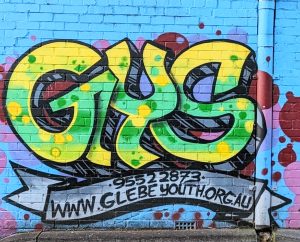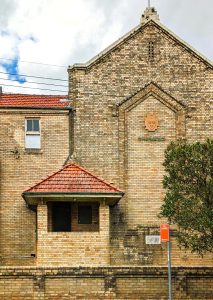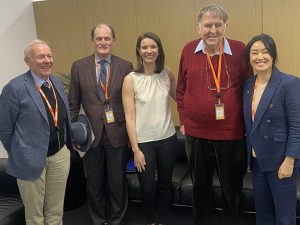 by Ian Stephenson, outgoing President, from Bulletin 8 of 2023 (October)
by Ian Stephenson, outgoing President, from Bulletin 8 of 2023 (October)
I acknowledge the Gadigal people as the traditional custodians of Glebe and Forest Lodge and pay my respects to elders past and present. I express my gratitude that we share this land today, my sorrow for the costs of that sharing, and my hope that we can move towards a place of justice and partnership together.
Glebe’s topography, ecology, history, buildings and people combine to make it a place like no other.
The Society has three pillars – Community, Environment and Heritage, but in a very real sense all our work is about nurturing Glebe’s community. The fact that we have 411 members shows our work is valued.
Highlights from the last year include:
Communications
The Communications Committee led by Allan Hogan implemented new systems to make the production of our monthly Bulletin easier and improve succession planning. Our website was upgraded. It is widely acknowledged for its good design, clarity and as a comprehensive source of knowledge about Glebe and is a major medium of outreach. We also have a presence on social media including Facebook and Instagram.
Allan very ably facilitated the local candidates forum for the State election at the Glebe Town Hall.

Ecology
The Blue Wrens, our ecology arm, was led by Andrew Wood. Judy Christie led the Orphan School Creek Bushcare Group and Anna Szanto the Glebe Palmerston and Surrounds Landcare Group. The subcommittee maintained a watching brief over four other parks with Rozelle Bay – David Lawrence, John Street Reserve – Norma Hawkins, Paddy Gray Reserve – Bryan Herden and Harold Park / Johnstons Creek – Janice and Nick Sangster. Judy Christie and Helen Randerson helped write the Society’s response to the City’s Street Tree Master Plan and Urban Forest Strategy.
The Craney Small Grants program awarded $1,700 to Glebe Public School for a project entitled ‘Glebe Public School Environment Project’ and $600 to the Crescent Early Learning Centre for a project entitled ‘Helping Bees Thrive’.
A highlight was securing an Innovation and Ideas Grant from the Council to do a comparative study of the fauna of The Hill, near the Tramsheds and three other Council reserves. It is an exciting project which has captured the community’s imagination. Good things do not always come easily, and the Wrens are to be commended on their determination to get the different entities in the project to work in concert.
Heritage
Rodney Hammett of the Heritage Subcommittee reviewed all the development applications lodged in Glebe for their impact on contributory and listed buildings. He cast his forensic eye over heritage impact statements and provided specialist advice on the history of land titles in Glebe. Brian Fuller prepared a submission for the review of the NSW Heritage Act. The Society remains concerned that the Division 5 Maintenance provisions of the Heritage Act are not being applied and that three State Heritage-listed items in our area: Bidura, the railway viaduct and the Glebe Island Bridge are suffering from demolition by neglect. The latter two belong to the State government.

The Heritage Subcommittee, with the assistance of Lyn Collingwood and Rodney Hammett, researched and published many articles about the history of Glebe. They also answered research enquiries from members and the public. The NSW Heritage Office accepted the Society’s nomination of a blue plaque on the house of cricketer Tibby Cotter. It has been installed and looks very handsome. We have been advised that another Glebe notable is likely to receive a plaque in the next round.
The Society was pleased to receive a federal volunteer grant through our local Federal member the Hon. Tanya Plibersek to develop a research database to make our research into Glebe more accessible.
Community
Louis Taborda assumed the role of Community Development Convenor last October. Louis is a lecturer in the School of Project Management at the University of Sydney. He held a workshop for the Management Committee last January to identify potential projects in Glebe for Master of Project Management students and has initiated several projects including:
- A main street study which is investigating global initiatives/options that may be applicable to Glebe.
- Glebe’s Chinese Heritage: researching early multi-cultural contributions in Glebe’s history.
- Glebe Market Stall: developing a business case for establishing a ‘presence’ at the Saturday Glebe Markets.
- A fundraising project for Centipede. Centipede is a not-for-profit organisation which operates out of school hours care for children at Glebe Public School.

The Society continued to support the Glebe Youth Service and hosted one of the Pyrmont Community dinners at the Tramsheds doing the catering and the entertainment. Our choir, Glebe Sings, performed a snapshot of Glebe’s history in song, featuring Premier Askin with ‘Run, Run the Bastards Over (as I said to LBJ)’, The Green Bans with John Dengate’s ‘Take Your Bulldozers Away’, ably led by Dale Dengate, and, as a tribute to Glebe having Sydney’s first Women’s centre, Women’s Liberation House in Glebe Point Road, the show stopping ‘I am Woman’. The Society collaborated with resident groups in Millers Point, Ultimo and Pyrmont to improve community centres across the city. The Council has provided a staffed centre at St Helen’s and is installing audiovisual equipment at Benledi which will greatly improve the facility for meetings and presentations. I would like to thank Lord Mayor Clover Moore and Kirsten Woodward, Manager of Social City for these initiatives. We participated in the loneliness forum facilitated by Deputy Lord Mayor Sylvie Ellesmore. We see Glebe’s broad social demographic, low-rise urban form and active volunteerism as important elements in fostering connection and combating loneliness.

Events
Dorothy Davis and Katharine Vernon produced a rich program of walks, talks and inspections. They included our first house inspection for some years, a viewing of a contemporary dwelling by architects Chenchow Little in Ferry Road. Another highlight was Max Solling’s Toxteth Estate walk which was followed by an inspection of Toxteth Park courtesy of the Sisters of the Good Samaritan. We received requests to run activities for groups outside Glebe, including a talk to the Pyrmont Historical Society comparing the history of Pyrmont and Glebe and a re-run of The Good the Bad and the Ugly, the history of infill housing in Glebe for 40 members of the Illawarra Branch of the National Trust.
The Events program is a great way to share the magic of Glebe and to meet new people.
Planning
Asa Wahlquist represented the Society on the New Sydney Fish Market Community Consultative Committee and has produced an outstanding report analysing its impact on traffic. Asa also prepared detailed submissions on the Blackwattle Bay State Significant Precinct development and the Bays West Master Plan.
As Planning Convenor, assisted by Brian Fuller, I prepared many submissions and addressed the City of Sydney Local Planning Panel on several occasions.
The Society was pleased to be approached by a resident of Forest Lodge who wished to reinstate the two-storey verandah of her house as accurately as possible. Although we were unable to locate a photograph we found quite rich physical evidence as to the scale, roof form and structure to inform the recreation. We were pleased to support the development application. The result is excellent.
In Avenue Road the Society prepared a report documenting the missing details on the façade of an Edwardian house which, in the 1970s, had been shorn of its bay window, fenestration, and richly ornamental stucco decoration. It is very pleasing that the owners have restored this detail as part of a larger development. The result is excellent. The house now takes its proper place in what is one of Sydney’s finest Edwardian streetscapes.
The Society welcomes enquiries from owners about the history of their houses and is always pleased to share its knowledge.
Our submissions were sometimes supported by the consent authority; for example, the rejection of an application to demolish most of the interior details, including walls and chimneypieces, of a house which was individually listed, in part because of its intact interiors. Sometimes our submissions were supported in part and on other occasions were unsuccessful.
Most of Glebe is included in heritage conservation areas. They are unusually rich in terms of their large number of Contributory buildings. They have well-developed planning controls providing guidance as to how houses can be extended without compromising the significance of the heritage conservation area. Council staff have heavy workloads, so the role of the Society in providing well-informed submissions on development applications is an important contribution to achieving good outcomes.

We supported the application to convert the upper two levels of St James Hall in Woolley Street to affordable housing but opposed the inappropriate treatment of the porch of this very intact façade. We were pleased that the Local Planning Panel shared our view and recommended that the porch be retained.
The long, complex, and contentious saga of the Bidura development has finally been resolved with a development application approved last month. We raised with the Local Planning Panel the need for urgent maintenance to be carried out on Bidura House and were pleased that the panel added a condition, suggested by conservation architect Paul Davies, that repairs and maintenance must commence within six months of the approval of the DA.
The State Government is the largest landowner in Glebe. Pleasingly, the new government resolved to stop selling the old Church estate houses. They have housed tenants on low incomes for over 150 years. It is important that Glebe retains its broad social demographic with rich, middle class and poor living in old houses. More maintenance is also being carried out. The Society was pleased that Minister Jackson announced the retention of the Franklyn Street estate. We congratulate Hands off Glebe and particularly Hannah Middleton, Denis Doherty and Emily Bullock for their tireless work.

We are currently working with Hands off Glebe on a campaign to stop the demolition of 82 Wentworth Park Road. This well-designed public housing complex was built in 1986. The NSW Land and Housing Corporation has lodged a development application to demolish it replacing the existing 27 public housing bedrooms with 53 bedrooms at a cost of nearly $22 million. Hector Abrahams of Hector Abrahams Architects has prepared an alternative scheme for the Society. It involves refurbishing the existing building and erecting a new building at the rear of the site, and will provide a total of 52 bedrooms for $14 million. It has many benefits, not only because it is significantly cheaper. It does not reduce the supply of public housing for several years (as demolition does), fits in better with the Lyndhurst Heritage Conservation Area and produces fewer greenhouse emissions. We have met with Minister for Housing Rose Jackson who has agreed to have a technical meeting to explore the merits of the refit, refurbish and extend approach.
Finally, I would like to thank the many other people who contribute to the Society, including our archivist, Lyn Milton and our team of Bulletin deliverers Mary Pollard, Mark Gorta, Helena Klijn, Lyn Milton, Dave McMillan, Mark Stapleton, Phil Young and Jude Paul.
Thank you for the privilege of acting as your President.










There are no comments yet. Please leave yours.